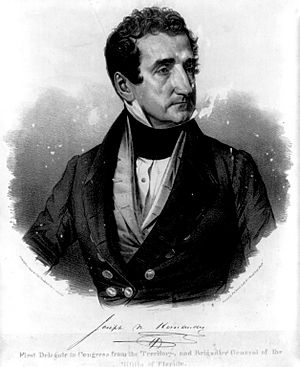Joseph Marion Hernández facts for kids
Quick facts for kids
Joseph Marion Hernández
|
|
|---|---|
 |
|
| Delegate to the United States House of Representatives from Florida Territory's at-large district |
|
| In office September 30, 1822 – March 3, 1823 |
|
| Preceded by | Office established |
| Succeeded by | Richard K. Call |
| Personal details | |
| Born | May 26, 1788 St. Augustine, Spanish Florida, Viceroyalty of New Spain |
| Died | June 8, 1857 (aged 69) Matanzas, Captaincy General of Cuba |
| Resting place | Necropolis San Carlos Borromeo |
| Political party | Whig Party |
| Known for | First Delegate from the Florida Territory and the first Hispanic American to serve in the United States Congress |
Joseph Marion Hernández (born May 26, 1788 – died June 8, 1857) was an important American politician and military leader. He made history as the first person to represent the Florida Territory in the United States Congress. He was also the first Hispanic American to serve in Congress. Hernández was a member of the Whig Party. He served in Congress from September 1822 to March 1823.
Contents
Early Life and Political Career
José Mariano Hernández was born in St. Augustine, Florida. This was during Florida's time under Spanish rule. His parents were from Minorca, an island in Spain. They first came to Florida as workers in a colony called New Smyrna.
Before Florida became part of the United States, Hernández owned three large farms. These farms were south of St. Augustine. Their names were San Jose, Mala Compra, and Bella Vista.
On February 25, 1814, he married Ana María Hill Williams in St. Augustine. Ana María was born in St. Augustine in 1787. Her parents had moved there from South Carolina. Hernández and his wife had at least one child, Dora Hernández.
In 1819, Spain gave Florida to the United States. This happened through a deal called the Adams–Onís Treaty. Hernández promised his loyalty to the U.S.
After the Florida Territory was set up, he was chosen as Florida's first representative. This role was called a "Delegate." He was approved by President James Monroe on September 30, 1822. This made him the first Hispanic person to serve in the U.S. Congress. He served for about six months, until March 3, 1823.
Military Service and Later Life
After his time in Congress, Hernández served in Florida's local government. He was part of the Territorial House of Representatives. He even became its leader.
He continued to manage his farms. Sadly, during the Second Seminole War, his farms were burned by the Seminoles. The remains of one farm, Mala Compra, is now a protected historical site.
During the war, Hernández became a Brigadier General. He led a group of volunteer soldiers. He also joined the United States Army and served from 1835 to 1838.
Hernández was ordered to capture important Seminole leaders. He was responsible for the capture of Osceola, a famous Seminole chief. He also captured chiefs Ee-mat-la (King Philip) and Uchee Billy. He left the army as a Brigadier General.
In 1845, Hernández tried to become a U.S. Senator. He ran as a Whig candidate but did not win. Later, he moved to Cuba. He became a farmer there, near a city called Matanzas. He passed away at his family's sugar farm in Matanzas Province. He is buried in the Del Junco family tomb in Necropolis San Carlos Borromeo, Matanzas.
Building the Hernández–Capron Trail
In 1837, while in the U.S. Army, Hernández received an important order. He was told to build a road between St. Augustine, Florida and Fort Capron. Fort Capron was located near what is now Fort Pierce, Florida.
Hernández led the effort to mark and clear this route. Twelve years earlier, another person named Col. James Gadsden had started clearing a path along the coast. Hernández's road followed this path. It went from Fort Capron through several other forts. These included Fort Vinton, Fort Drum, Fort Kissimmee, Fort Meade, and ended at Fort Brooke (which is now Tampa).
See also
 In Spanish: José Mariano Hernandez para niños
In Spanish: José Mariano Hernandez para niños

